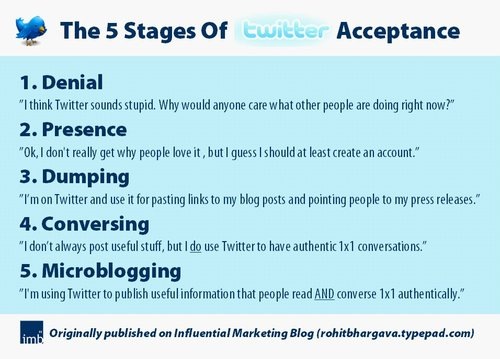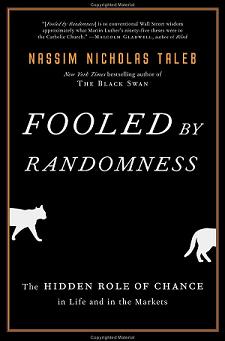Video interview on Project Shrink
Bas de Baar of Project Shrink just recently interviewed me (video) about my book Blog Bazers and why blogging is important for project managers. In the interview he asks me the following questions:
- Most of my viewers are Project Managers and other professionals. How would you convince them to start a blog?
- What are your personal 3 favorite tips you encountered during the book interviews on how to write successfully blog posts?
- If people have one day of spare time, have the desire to start a blog, how would you recommend they arrange their day?
If you’re interested, you can view the full interview on Bas’ blog Project Shrink here.
Thank you Bas for interviewing me. It was a lot of fun and the interview turned out really good.
Permalink to this article Discussions (0)
Who Should Make the Decision?

Is it the person in charge that should make the final decision? Sometimes, but not always. It should be the person who’s most knowledgeable with the information on which the decision will be based.
Let me give you an example. In the tv show 24, this season the president of the United States was taken hostage in the White House by a small team of armed men. Yes it’s quite a story, but let’s ignore that for now. What was interesting is that the decision on whether or not to storm the White House and retake control was not decided by the agents that were following the case the whole time, those that knew who the terrorists were and had studied their histories, those that really understood their motivations and intentions.
Instead the decision was taken by the Vice President. He didn’t even know what was going on, he was just quickly appraised of the situation, well as much as they could within minutes, and he had to make a decision on whether or not to storm the White House. There’s no way this person could make the right decision unless it was pure luck. There’s was just too much history and information needed to full appreciate and understand the situation. Plus, he had additional motives (such as protecting himself) which came into play. In this case the wrong person to make the decision was the person in charge.
Of course this is only a tv show, but it happens all too often. Especially in software development. I can’t tell you how often I’ve seen developers struggle and fight through a hard problem only to come to a fork in the road. They then have to go to the team lead / manager (or whoever is in charge, which is sometimes someone who’s not at all technical) and have to explain the issue. Now if it’s a good lead, they will listen to the developer and pretty much let them lead the decision, after all they’ve been in the thick of it while the leader only superficially knows and understands the issues. It makes sense and is the smart thing to do.
However many times the opposite happens. The suggestion is completely ignored and the developer is told to just make it happen (even when they strongly disagree and push against it). My favorite is “I understand you might not think this is a good idea, but just do it anyways.” The reality is that someone working on a problem for hours or days can’t really express the full issue in minutes. It’s just not possible, so what you get are the highlights, the glance over. If you really want to make the decision, than dig into it, spend some time to really appreciate what’s going on. Expect to spend some hours, maybe even days to fully understand what’s going on. Especially if the decision has large implications for the future.
The reality though is that sometimes the developer is not perfect either, they might not appreciate everything else that’s going on. Maybe there’s political factors. Maybe there’s monetary factors. Maybe some timelines with the marketing team that need to be met, etc. If you can (I understand that sometimes it’s not possible), than share with your developers other factors that will affect the decision. Help them rather than just make the decision outright based on only one factor. In other words, don’t just pick option A because it will allow you to meet your deadline while option B won’t because it might come back to bite you very hard. If the developer is pushing option B so adamantly, figure out why. And only then make your decision. Don’t just base it on one factor that you know, understand the full problem. Work together to come to a decision.
Permalink to this article Discussions (0)
Blog Blazers at Drake University

Since I published Blog Blazers a few months ago, the reviews have been great! A while back I sent Mike Sansone a copy of the book to review for his blog ConverStations and he liked it so much that he’s decided to use it for his workshop at Drake University! How great is it to see your book used in a University workshop? Especially as it’s only been a few months since it’s been available!
To quote Mike’s review:
“There are a lot of blogging books out there. Many are good, but I’ve found Blog Blazers to be a gold mine of instruction. That’s why I’m recommending it to my students in one-on-one and classroom settings. Stephane Grenier quizzed 40 fantastic blog authors on how to create a high-profile, high-traffic, and high-profit blog.
…
If you’re coming to the Drake University workshop on Saturday, we’ll be talking a lot about this book.”
Thank you Mike, it’s awesome to hear you’ve decided to use Blog Blazers!
Permalink to this article Discussions (2)
The Power of Google Alerts

Have you ever wanted to know what’s being published online about you this week, today, or maybe even right now? Well you don’t have to worry anymore. And no, you don’t have to continually keep surfing all the nooks and crannies of the web to find out. It’s much simpler than that, all you need to do is setup a Google Alerts.
So what are Google Alerts? According to Google itself: “Google Alerts are email updates of the latest relevant Google results (web, news, etc.) based on your choice of query or topic.”
From my perspective, it’s a way for me to keep track about what’s going in regards to myself on the internet. I can find out when new posts about me (Stephane Grenier), my blog (FollowSteph.com), my book (Blog Blazers), or even my company (LandlordMax) appear. It’s great to be able to keep up with everything that’s being posted about you!
But it’s more than that, and herein lies the power of Google Alerts. Not only are you able to find out when things are being said about you so that you can know, and possibly react, but you can also get Google Alerts about any keyword!! That’s a huge benefit!
For example, if you’re website is about “Dog grooming”, wouldn’t it be awesome to get all the latest webpages Google indexes into it’s search results for “Dog grooming”? If it’s a blog post maybe you can contact the author, add to the discussion by leaving a comment, and so on. If it’s an existing discussion on a forum, maybe you can join in and participate. Just be careful not to spam whatever page you get alerted to, it will eventually come back to you. The key is that Google Alerts can alert you about new discussions and articles related to your keyword/niche, which in turns allows you to join those which interest you. How great is that?
And here’s an extra little trick. You can also setup Google Alert’s for your competitor’s names. The reason this is interesting is that it allows you to have an idea of what they’re up to. And you might find some interesting tidbits of information here and there that you can learn from. But overall, it’s a great way to keep track of what your market niche is doing.
So if you haven’t already setup Google Alerts, I strongly suggest you do. They’re great and extremely easy to setup. Even better it’s free! You’ll definitely get your time’s worth. And if you’ve already setup Google Alerts and you’re using them, please feel free to share your story of how you’ve benefited from them.
Permalink to this article Discussions (6)
Which Stage of Twitter Are You At?
Having heard and read so much about Twittter, I’ve just recently become a Twitterer myself (StephaneGrenier) to see what all the hoopla was about. And I have to admit, I was pleasantly surprised. I’ve already gotten a lot of value out of it, and I’ve just joined a bit over a week ago!
There are lots of benefits to Twitter, but it mostly depends on who you are. That is, the Twitter experience is going to be very different for different people. For most people, the obvious benefit is self-promotion (just like for blogs). However that’s just a very small part of it, just like blogging.
Rohit Bhargava wrote a very good post titled: The 5 Stages of Twitter Acceptance. Where are YOU at? And I have to agree, it’s very accurate. Well with the exception of stage 1, I wouldn’t necessarily call it denial, but more along the lines of not really having time to check it out since you can’t clearly see the value. And stage 2 being where you still don’t fully get it but you’re willing to commit to taking the time.
Having just joined a week ago, I’ve jumped from stage 1 to stage 2. The good thing is that I skipped stage 3 entirely. I’m now working my way between stages 4 and 5, but I don’t know that I’ll ever completely get to stage 5. Sometimes it’s nice just to post the odd distraction. Like last night when I was tired from coding for the better part of the day, I decided to post a couple of entertaining links. Things I found interesting but that didn’t really offer any value other than entertainment. I don’t believe you can be all business all the time, sometimes you have to have a lighter side (and what I have entertaining is not always useful). Which is why I might never make it completely to stage 5.
That being said, although I’m probably not the normal Twitterer, I believe the 5 stages of Twitter Rohit describes to be very good and accurate. I’ve found, in the little time I’ve been Twittering, that a lot of people get caught up in stage 3 of self-promotion. I even had to stop following some people because almost all of their tweets where stage 3 tweets (that or they were tweets of links to their latest blog posts). I’m following you on Twitter for a reason, and it’s not just for self-promotional tweets (a certain level is acceptable, but not the majority). The good news is not everyone does this, but unfortunately enough do. The other thing I’ve found difficult is trying to follow more than a few dozen people, I find there’s just too much noise. But that’s another post for another day (I’m still learning).
The good news is that there are a lot of people at stage 4 and 5. And that’s great! It’s because of this that I’m really enjoying my Twitter experience. My only regret is not having started sooner.
Which leads me back to my original question, which stage of Twitter are YOU at?
Permalink to this article Discussions (8)
Is it a Good Time to Buy Real Estate?

It depends. Don’t you absolutely hate that answer? But the reality is that it really does depends and any other answer is wrong.
It really does depend on the situation and circumstances. For example, it might be a good time to buy real estate in New York city while simultaneously being a bad time to buy in Los Angeles. And even then, and much more importantly, it might be a good or bad time for you personally to buy real estate (or any other revenue generating asset such as stocks, bonds, etc.)!
Let’s look at a simpler case study than real estate to get a better understanding. Let’s pretend you’re the owner of a movie rental store. Instead of real estate, you buy and rent DVD’s. Is it a good time to buy DVD’s? It depends. Firstly how much do the DVDs cost in terms of how much you can rent them for? In other words, will the DVDs make you money? And how long will it take you to start being profitable from buying and renting DVDs?
Before we go on, remember that although you can buy a DVD for say $40, that’s not necessarily your true cost. You also have to include the cost of employees, rent for your store, marketing, people bringing back the movie late, lost inventory, insurance, accountants, etc. However for the sake of this discussion let’s keep it simple, let’s assume the real cost is double the purchase price.
Taking an example, if our total cost to buy a DVD is $80, and we can rent the movie out at $5/day, then it will take 16 days to start making any profit. Not bad. But wait, it’s not that simple. Is the movie going to be rented 16 days in a row? That’s a probability, and you have to assume no. In real estate, we use a similar concept, the vacancy rate, which signifies the percentage of unoccupied units. For now we’re just going to assume the DVD is fully rented. And since most people rent a DVD one day and return it the next day (sometimes two), we’ll use 32 days as a safer assumption. At 32 days, it’s not looking too bad.
But we’re not done. What about late returns? Right now most video stores allow you to return a movie late (by over a week) with no late fee. This will unfortunately over complicated our example, so let’s just assume we can’t charge late fees. Therefore instead of 32 days, we’ll pad our estimate to 60 days, or 2 months. It’s simple and should be good enough.
Is it a good time to buy now? It still depends! Can you actually rent your DVD’s at $5/day in your local area? Are you in a poorer area where $5/day is considered a luxury? Maybe you can only charge $2/day. Or maybe you live in Beverly Hills and you can charge $20/day because you offer mocha lattes for each of your visitors as they peruse your store. The price you can charge for your revenue generating asset, in this case DVD movies, will greatly affect whether or not it’s a good time to buy. At $2/day, it will take you at least half a year of continued rentals to make any profit. Can you rent the DVD for half a year non-stop? Not likely. Most movies fade out of popularity within months, if not weeks, before other newer movies take their place. Hence at $2/day, it’s probably not a good time for you to buy. However if you can rent the DVD at $20/day, it will take you only 2 weeks to start making a profit instead of 2 months. A much better time to buy. Well maybe.
We still can’t know if it’s a good time to buy. Why? What about the specific asset, or in our case the specific movie. If the movie we’re buying is the latest multi-gazillion blockbuster, then it’s probably looking good. But what if it’s the latest Hollywood straight to DVD flop that absolutely no one wants to see? Probably not. We might never even be able to rent it once! It could be a complete lost of time and money. Again, it depends.
But let’s assume it’s the best movie ever made in all of history, and we can rent it out at $10/days and it will only cost us $50 total to buy. Is it still a good time? Again, it depends. What if all you personally have left in your bank account is $10 (and maybe even that $10 is allocated to other pre-existing payments). Then you can’t afford it.
Can we get a loan for the $50? Maybe, but can we afford the payments? Can we carry the loan? We’re assuming it’s the best of the best movies, but what if it’s not? Poseidon anyone? Ignoring that we might make enough money to cover our loan payments on the principal, what about the interest? Can we get an affordable loan at an interest rate that will give us a comfortable return (I say comfortable return because we all have different thresholds for risk)? In other words, even if it’s the greatest deal, can we afford it. Does our personal financial situation allow us to capitalize on it?
So the next time someone asks you: “is it a good time to buy?”, I hope you’ll say it depends because it really does depend! It depends on the specific situation, circumstances, and the assets you want to buy.
PS: I didn’t include the long tail in this example, that is movies that have been out for years and still continue to get rented often. These are very profitable. And the same is true for real estate properties, stocks, etc. Generally the longer you hold onto them, the more money you’ll make. Instead I tried to focus on whether or not you’d be able to get to that longer tail, that if you can at least start making a profit on the assert within a reasonable amount of time.
Permalink to this article Discussions (1)
Interview with Sam Berns founder of WithoutaFather.com
We’re fortunate today in that I am able to share with you an interview I did with Sam Berns, the founder of WithoutaFather.com, a website aimed at helping teens and children growing up in single parent homes. In the US alone there are over 21 million such kids.
I’ve known Sam for several years now, and I can tell you he’s very passionate about everything he does. It came as no surprise that he would leave his consulting career to dedicate himself fully to this website. When I first knew him he was a volunteer with Junior Achievement and has helped over 100 high school kids start their own businesses. He chose to volunteer in the more disadvantaged schools in the city, and the interesting thing is that no matter were he went, the kids he mentored were always the most successful.
He’s tried to recreate elements of that mentorship online with his website. Professionals in all fields can sign up, create a profile that protégés can browse and post questions on their profile page. This allows the online mentors to offer advice, inspiration and encouragement in the time it takes to reply to an email.
One example is a young protégé who asked for advice on how to beat her interview jitters from an online mentor, who’s profession is to constantly hire teens. He was able to offer her some really great advice and help her significantly improve her job interviewing skills. He’s helping her get the job she wants, not the job she has to take.
So without further ado, here’s the interview I had with Sam:
Steph: What did you do before you started WithoutaFather.com?
Sam: I did application design and financial modeling. Basically I worked with managers and helped them predict the financial outcomes of their business decisions. That can mean creating a business case, a financial model or designing new applications that allowed us to do that.
Steph: What was it like to quit your job and focus on this project entirely?
Sam: It was a bit scary. To go from a paycheck every two weeks to none is something you have to accept. It helps if you live well within your means and have some money saved up. Every entrepreneur knows this feeling, in the end you have to believe enough in what you are doing, that is the price of admission.
Steph: How did you end up helping teens growing up without a father?
Sam: I grew up without a father myself and I knew I wanted to do something to help them, I just didn’t know what. Kids growing up without a father are 5 times more likely to grow up in poverty than kids growing up in married-parent homes and are twice as likely to drop out of high school.
The idea was to create a website that would try to deal with as many of those challenges these teens face. I was struggling to build this website on my own and got very lucky when a former client heard about what I was doing and offered to help me out.
Steph: Do you mind if I ask who the former client was and how they helped you? It’s always great to hear about the power of reciprocity, especially in business.
Sam: The former client is an interactive studio called Fuel Industries. Warren Tomlin is the Chief Creative Officer, he got wind of the idea and mentioned it Mike Burns, their CEO who took me to see Brian Nesbitt, their CTO and I’ve been working out of their offices ever since. These guys made the website so much better than what my initial vision was.
Steph: Can you tell us specifically how the website helps teens?
Sam: Sure, the website is divided in 4 sections. There’s an advice section, a resume application, a budget tool and the online mentorship program.
The advice section is really born out of everything I wish someone had told me when I was growing up like how to get good grades or how to tell if a girl likes you.
The resume tool is to help these teens access the workforce on their own.
The budget tool teaches them the importance of savings and being able to afford big things like a post-secondary education.
And finally in the online mentorship program, we try to attract professionals from all sectors to share their story of success and let our young protégés contact them on their profile page and ask them questions that will help and encourage them to continue on with their own education after high school and find their own success through education and hard work.
Steph: How is WithoutaFather.com doing right now? And where do you see it going in the future?
Sam: We’re slowly building traffic and have noticed that people spend a lot of time on the website, with a lot of them using our resume builder and budget builder tools, which is great. Over the next couple of months, I’ll be reaching out and trying to attract more online mentors and will be visiting more high schools to talk about the website and how it can help them.
Steph: Thank you Sam for taking the time for this interview today, it’s really appreciated. I wish you all the best with WithoutaFather.com, especially since it’s such a noble cause.
Sam: It was my pleasure! Thank you Steph.
Permalink to this article Discussions (1)
Business Idea: Specialized Check Printer
Like I’ve said before, ideas are a dime a dozen. What it really takes to make a business is more than just an idea, it takes the execution of the idea. And this is by far the hardest part. I myself have no trouble coming up with new ideas. I actually have lots of them. The problem is that I can’t execute all of them. I just don’t have the time and the resources. So today I’m going to share with you my latest idea. And please go ahead and take it if you want. I’d love to see this product make it to the market! I’d buy it in a heartbeat.
Basically the idea comes down to a simple need, the ability to print checks from my computer. Right now in the market there are many great label printers, which is awesome. We use Dymo label printers here at LandlordMax to help us (it’s great for mailing labels amongst other things). It’s an amazing time saver. As good as having sheets of Avery mailing labels are, I often just need to print one label, of even just a few labels and not an entire sheet of labels. Hence I almost exclusively use the label printer (I actually only use the Avery sheets to print large quantities of return mailing addresses).
Now imagine if there was a printer just like the Dymo label printer, but for checks! How cool would that be?
There’s some details that would need to be ironed out. For example what do you get with a roll of checks? Does it print out your account information on the bottom of the check or just fill in the fields like the date, payee, etc. That’s the 99% perspiration part, I’m just giving the 1% inspiration.
The key to this printer’s success of course is to make it very easy to use and integrate with. If there was such a printer, and it was very easy to interface/integrate with, we’d almost certainly be supporting it as the primary check printing option for LandlordMax.
You see right now for a software to offer check printing, which we’re in the process of implementing for LandlordMax, you either need to jump through hoops or highly limit the capabilities of your check printing feature.
It basically comes down to a couple of options. The first is to support only pre-defined formats, but this means you’ll also have to sell checks “compatible” with your software. Not exactly where we want to go for LandlordMax. The alternative is to create some form of a “check designer” which allows you to configure how the checks are printed. Of course this option is much more complex for the software company to implement, and hence costs more. But not only that, most users aren’t really interested in configuring their printer alignments just to be able to print checks.
So there you go, a business idea that will solve a common and annoying problem faced by both consumers and businesses. Just think of the possibilities. Hopefully someone will take this idea and run with it!
And if you know of a check printer like this that already exists, please let me know. I’d be very appreciative.
Permalink to this article Discussions (10)
I'm Immortal
I’m Immortal and I can prove it using valid and correct statistics! It’s pretty simple actually. To prove my immortality, I’m going to use the data from my life.
Here’s how the proof goes. Since the day I was born I’ve never had a day in which I died. Being my age, that’s just under 13,000 days. A fairly decent sample size (I think that with 13,000 flips of a coin we could determine the odds of getting heads or tails). But maybe for those of you who aren’t yet confident, let’s increase the sample size. In all 18,408,206 minutes I’ve lived (give or take a bunch) I’ve never died. Not once!
So based on my past data, the odds of me ever dying are less than 0.00…1%. In other words I’m virtually immortal! How cool is that?
However as we all know this logic is flawed, I will one day die. I’m no more immortal than anyone else. However there is no error in my logic. My sample size is large, quite large (over 18 million data samples with not one instance of me dying). Definitely enough to get a very high level of confidence, statistically speaking that is.
The flaw is that I can’t prove something positively, I can only ever really disprove something. In this case, just because I’ve lived over 18 million minutes without dying, doesn’t mean I’ll live another minute. In other words I can only prove that my theory is false, I can never be sure that my theory is true. I can be more confident, but I can never be sure.
And this is exactly what’s gotten the world in such financial trouble. Statements like “The market never goes down x% in a given month.” or “The US government can’t collapse.”. Our sample size just isn’t big enough. We can never prove this to be true, we can only disprove it. Just like we can’t disprove/prove we’re immortal until we die.
Therefore you have to be careful of what’s being said out there. Remember that rare events do happen, and they happen much more frequently than we think. Several are happening right now. The Feds bringing the interest rates to near 0%. The real estate market collapsing on itself. Deflation looking like it might be a real possibility. The government needing to bailout the corporate world on a never before seen scale. It’s all happening, yet it’s not possible. Another once in a lifetime event is happening again and again and again…
However there is good news. Learning and knowing to appreciate rare events can be an incredible benefit. You should plan for them, because although rare they do happen very frequently (that last sentence sure sounds like something Yogi Berra would say).
If you’re interested in learning more about this, I strongly recommend the books Fooled by Randomness and The Black Swan (the inspiration for this post). Both are amazing books that will really open your mind. And they’re not just about finance, they can be applied to anything in life.
Thank you also Jian for recommending these books.
Permalink to this article Discussions (5)
Tune into Small Business Radio Today

Today I will be on Small Business Radio hosted by Anita Campbell to talk about my latest book Blog Blazers at 1:30pm EST. Don’t forget to tune in as the topic of the show will be “Advanced Blog Tactics Used By Professional Bloggers”, which will come from both the interviews I conducted in the book Blog Blazers and my own personal experience. It’s going to be a great show so don’t miss it!
Permalink to this article Discussions (7)
| « PREVIOUS PAGE | NEXT PAGE » |






